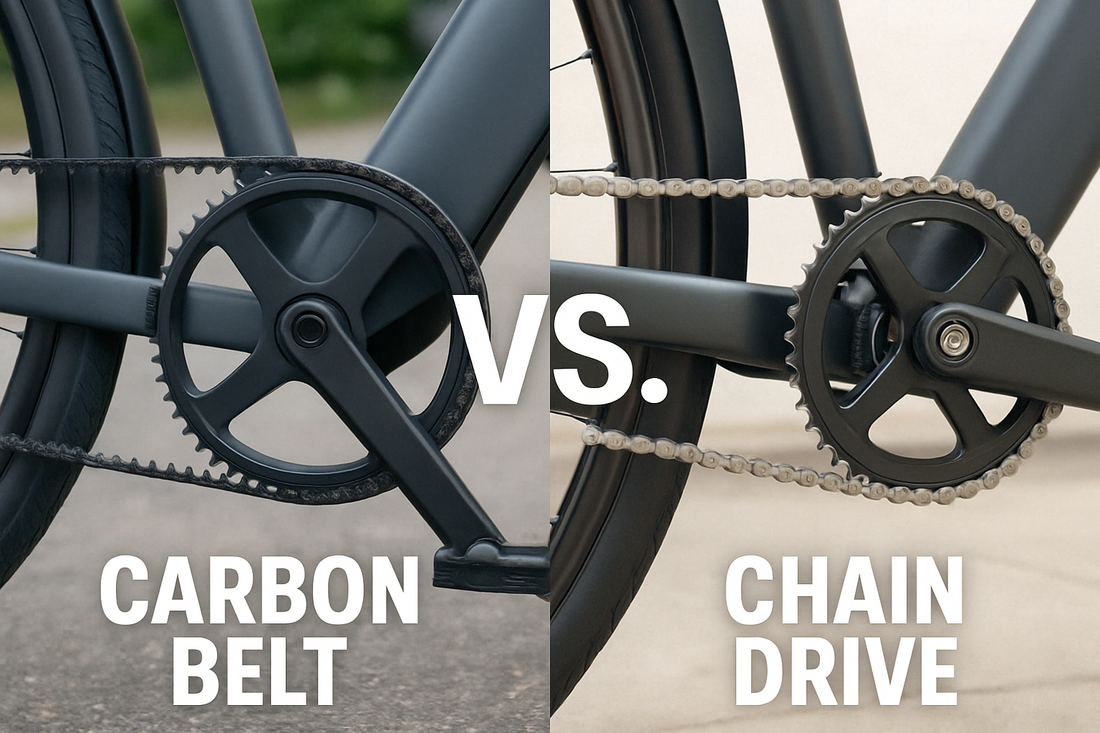
Carbon Belt vs. Chain Drives: What's The Difference?
Share
When shopping for an e-bike, one of the most overlooked but important features is the drivetrain. The two most common options are carbon belt drives and traditional chain drives. Each comes with its own pros, cons, and ideal use cases. So, what’s the real difference, and which one is right for your ride? Let’s break it down.
What Is a Chain Drive?
A chain drive is the classic bike setup you’re probably familiar with; metal links, sprockets, and derailleurs. It’s been around for over a century and is still widely used today, even on many electric bikes.
Pros of Chain Drives:
-
Affordable: Cheaper to replace and maintain.
-
Widespread compatibility: Works with most gearing systems.
-
Readily available: Easy to find parts and service.
Cons of Chain Drives:
-
Requires maintenance: Needs regular lubrication and cleaning.
-
Prone to rust and wear: Especially in wet or salty environments.
-
Can be noisy: Especially if not well-maintained.
What Is a Carbon Belt Drive?
A carbon belt drive uses a high-strength belt (often made from carbon fiber-reinforced rubber) instead of a chain. It’s a modern alternative, especially popular in urban and commuter e-bikes.
Pros of Carbon Belt Drives:
-
Low maintenance: No oiling or lubrication needed.
-
Durable: Can last 2–3 times longer than a chain.
-
Quiet and clean: No grease, no mess, no noise.
-
Rust-proof: Perfect for beach towns or rainy conditions.
Cons of Carbon Belt Drives:
-
Higher upfront cost: More expensive to replace.
-
Limited compatibility: Doesn’t work with derailleur systems, only internal gear hubs or single-speed setups.
-
Harder to service: Not all shops are equipped to handle belt drive issues.
Carbon Belt vs. Chain Drive: Which Is Better for E-Bikes?
The answer depends on how and where you plan to ride your e-bike.
-
Commuters and casual riders will love the low-maintenance, clean feel of carbon belts, especially in cities or coastal towns.
-
Performance riders or off-road e-bike users might prefer the flexibility and gear range of traditional chain drives.
If you're riding your e-bike near beaches like Sea Bright or Monmouth Beach, where salt and sand can wreak havoc on metal components, a carbon belt drive might be worth the investment.
Final Thoughts
When comparing carbon belt drives vs. chain drives on e-bikes, think about your riding habits, budget, and maintenance preferences. Chains offer classic versatility and lower costs, while belts bring a smooth, quiet ride with fewer maintenance headaches.
Looking for an e-bike with either drivetrain? Browse our selection at Jesse’s E-Rides to find the perfect fit for your needs and lifestyle.
Internal Link Suggestions
-
For more on riding in accordance with state laws, check out our post on Understanding New Jersey's E-Bike Classifications
-
Learn how to maintain your chain with our Top Tips for Maintaining Your E-Bike
-
Make sure your bike is safe with our blog on E-Bike Security Tips
External Link Suggestions
-
Learn more about carbon belt technology from the experts at Gates Carbon Drive
-
Dive into the pros and cons of belt vs chain drives with this breakdown by BikeRadar
-
Explore long-term maintenance differences in this article from Cycling About


 Shrewsbury, NJ
Shrewsbury, NJ
 855-88JESSE (855-885-3773)
855-88JESSE (855-885-3773)
 hello@jesseserides.com
hello@jesseserides.com
